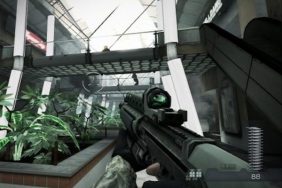There are games that try to do something new, and then those that try to do what’s already been done but better. The Order: 1886 belongs to the latter.
Ready at Dawn’s ambition led it to try and craft the richest and most immersive story it could with The Order: 1886. Along the way it became, perhaps, too focused on that goal. As the industry has evolved over the course of its project’s five year span, the game has aged along with it. But instead of becoming a fine wine, its flavor has become something bitter.
Knights of the Round
The Order: 1886 is set in a fictional London during the year 1886. Loosely drawing from the stories of Arthurian Legend, the game’s setting finds a healthy mix between the familiar and unfamiliar. On one hand its cast of finely dressed knights and 19th century architecture aren’t far-fetched from what’s detailed in history books, a presence of mythological beasts and steampunk elements make it one of a kind.
The story effectively piques your interest early on with its uniquely dark atmosphere and unmistakably beautiful art direction. There’s nothing on the market that quite looks like The Order: 1886, with its dreary catacombs and lavishing beards. It could very well become the best looking game you’ve ever seen.

As with many graphically-borne games, The Order: 1886 lives and dies by its progressive visuals. For the first few hours it’s easy to be seduced by its lifelike character models and impeccably detailed animations that could be mistaken as CGI. But this honeymoon doesn’t last forever. Around the halfway point (four hours in) the narrative loses its luster, and becomes a re-embodied tale you’ve heard before. Once the story and graphics lose their grip, there is nothing to replace them.
As with many graphically-borne games, The Order: 1886 lives and dies by its progressive visuals.
The Order: 1886‘s film-esque approach can even be a hindrance during gameplay. For example, Ready at Dawn chose to use a very close over the shoulder view during gameplay. While it makes the game feel more intimate, this camera location can be problematic during combat scenarios, obscuring your visibility. So, you can reasonably say that the game prioritizes form over function.
Ultimately, the biggest problem is that The Order: 1886‘s presentation and plot simply aren’t persuasive enough to carry the rest of the game.
A Gameplay Inquisition
Gameplay in The Order: 1886 makes up a roughly, and considerably small, 70% of the experience. But it doesn’t feel like it. While there are many sections where you’ll engage foes with your modest arsenal of weapons, you’ll learn that soon after it’ll be interrupted by yet another cutscene. Or worse, one of the game’s many quick-time events.
The good news is that The Order: 1886‘s combat isn’t held back by clunky shooting mechanics. Far from it. The third-person shooter mechanics are great in execution, and weapons feel powerful with a great sense of feedback. This feedback stems directly from the game’s outstanding presentation, where there’s an impressive attention to detail. Even the sounds of the game’s modest arsenal of weapons being fired are menacing and on-point.

What holds back The Order: 1886‘s combat sections from being anything more than ordinary is poorly implemented artificial intelligence. Enemies, put simply, behave idiotically. Even on Hard difficulty—the highest the game has to offer—you’ll see foes walk into one another and put themselves in poor situations as if they don’t know you exist. This ill-tempered shortcoming is significant enough that it directly impacts the excitement and immersion of the game.
There are a few other gameplay elements other than the ranged combat. For one, there are smoke and explosive grenades, the former of which can be great for tactical play if employed carefully. There’s also a melee system, but it’s nothing more than “press this button to trigger a violent animation”. There’s no strategy to it, and in many circumstances it’s far too powerful.
What holds back The Order: 1886‘s combat sections from being anything more than ordinary is poorly implemented artificial intelligence.
Then there’s Blacksight. This time-slowing system is helpful in a pinch, but is non-intuitive in operation. It doesn’t serve its role well of adding variety to the shooter experience.
Besides the good shooting mechanics, the shooting gallery approach of The Order: 1886 is quite standard fare, although there is a second enemy type you encounter early on that mixes things up. This second type of foe is much faster than the humans you combat. As such, you’ll be able to dodge via a QTE input while quickly tracking the foe. It’s a nice change of pace, although seldom encountered.
Related: Everything You Need to Know About The Order: 1886
When The Order: 1886 strays from this cover shooter system, it exposes its weakness. Stealth sections last far too long for their simplistic nature. Exploration isn’t worth your time unless you feel like reading paper scattered around the environment. Lastly, the game’s QTE battle sections feel out of place in a AAA PS4 exclusive in 2015.
An Abrupt Ending
The Order: 1886‘s cutscenes can’t be skipped. So, even if you rush through the experience you’re looking at a five hour game. If you take your time—like I did—you’re looking at around nine hours. While that’s a fine number, there is absolutely no incentive to go back and replay the game.

Some games can get away with having no multiplayer or co-operative element, but The Order: 1886 can’t. Its experience is too short and unfulfilling to operate on its own. There are no leaderboards, unlockable difficulties, or even collectibles. This is a game that relies entirely on you being captivated by the story it has to tell. There is nothing else to hold on to.
Conclusion
The Order: 1886 ends on a note that displays a full intention for there to be subsequent releases in the franchise. But in this day and age there isn’t any room for games that are costly to craft, and don’t stand out enough to be impactful. It’d be a surprise if a sequel ever saw the light of day.
Related: 16 Things You Might Not Know About The Order: 1886
It’s a shame because it has the foundation of something that could be truly remarkable. Its setting stands out from the endless sea of AAA games, and its visuals set a new bar for console games. Nonetheless, it makes you think more about what could have been rather than what it achieves.
It almost seems as if The Order: 1886‘s greatest fault is that it took too long to make. It’s laden with QTEs and other elements that have been scorned in recent years. In 2015 the standards are different. At $60, consumers expect something memorable, if not lasting. The Order: 1886 is neither.

Jonathan Leack is the Gaming Editor for CraveOnline. You can follow him on Twitter @jleack.
Copy provided by publisher. The Order: 1886 is exclusive to PS4.








